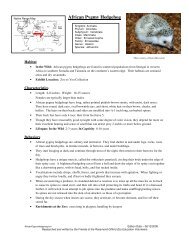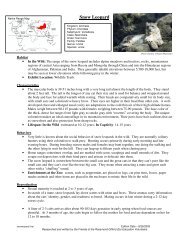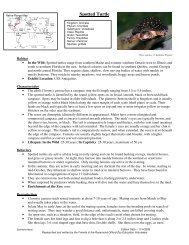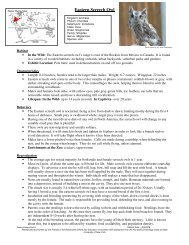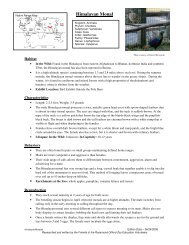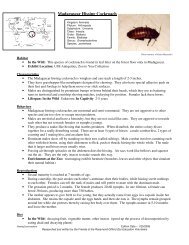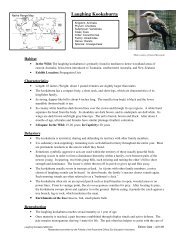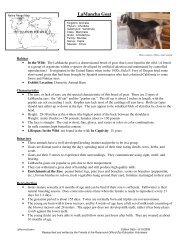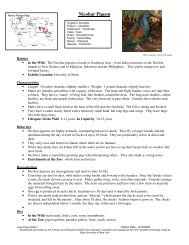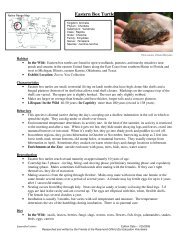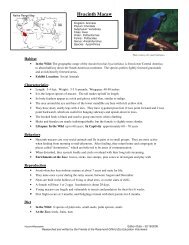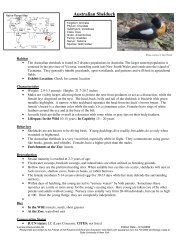Inland Bearded Dragon - Rosamond Gifford Zoo
Inland Bearded Dragon - Rosamond Gifford Zoo
Inland Bearded Dragon - Rosamond Gifford Zoo
Create successful ePaper yourself
Turn your PDF publications into a flip-book with our unique Google optimized e-Paper software.
Native Range Map<strong>Inland</strong> <strong>Bearded</strong> <strong>Dragon</strong>Kingdom: AnimaliaPhylum: ChordataSubphylum: VertebrataClass: ReptiliaOrder: SquamataFamily: AgamidaeGenus: PogonaSpecies: vitticeps<strong>Inland</strong><strong>Bearded</strong><strong>Dragon</strong>km Edition Date – 12/6/2005Researched and written by the Friends of the <strong>Rosamond</strong> <strong>Gifford</strong> <strong>Zoo</strong> Education VolunteersPhoto courtesy of Karen MarzynskiHabitat• In the Wild: The bearded dragon is native only to Australia, widely distributed throughout the interior ofthe eastern states to the eastern half of southern Australia and southeastern Northern Territory. They livein a variety of habitats including subtropical woodlands, scrublands, savannas, shore areas, and into greatinterior deserts.• Exhibit Location: <strong>Zoo</strong> to You CollectionCharacteristics• Length: 13-24 inches, including tail; Weight: 283-510 grams (0.6-1.1 pounds)• Males are generally larger than females.• <strong>Bearded</strong> dragons are appropriately named because of their beard, an expandable throat pouch with spikyscales. The beard is for both mating and aggression displays.• They have a broad, triangular head, round body, stout legs, and a robust tail. Their color depends on thesoil of the region they live in, ranging from dull brown to tan with red or gold highlights.• Lifespan: In the Wild estimated 4-10 years; In Captivity 10 yearsBehaviors• Adults are territorial. As they grow, they establish social hierarchies in which aggressive and quietappeasement displays form a normal part of their social interactions.• Both sexes have beards, but males display more frequently, especially in courtship rituals. The beardturns dark to jet-black and inflates during the display. They may also open their mouths and gape inaddition to inflating the beard to appear more intimidating.• The male will quickly bob his head up and down, often with a darkened beard. He does this to showdominance over smaller males and to females with which he wants to mate.• Beardies also stand on 3 legs and wave one of its forelimbs in a slow circular pattern. One function ofthis is for species recognition. It is also used to show submission (a small beardie will arm wave whenconfronted by a larger, more dominant beardie). Females also arm wave to avoid aggression from males,especially if the male is head bobbing.• Enrichments at the <strong>Zoo</strong>: rearrangement of exhibit furniture, daily handling, hibiscus blossomsReproduction• <strong>Bearded</strong> dragons reach sexual maturity at 1-2 years of age. Breeding season occurs during the warmAustralian summer months of September through March.• Females dig a burrow and lay up to 24 eggs per clutch and up to 9 clutches per year. They are also knownto store sperm and are able to lay many clutches of fertile eggs from one mating.• Eggs are 0.7-1 inch in length, ellipsoidal (similar to an oval), and are parchment-like to the touch.• Incubation lasts 50-70 days and is unattended by the parents. Hatchlings are 3-4 inches long when bornand are totally independent.Diet• In the Wild: plant matter, insects, spiders, small rodents, lizards
• At the <strong>Zoo</strong>: herbs, fruit, steamed yam, crickets, superwormsConservation Status• IUCN status: not listed; CITES: not listed• <strong>Bearded</strong> dragons are common in the wild and also as pets around the world.• Their main predators are snakes and kookaburras.Did You Know?/Fun Facts• Since the 1960’s, Australia has strictly prohibited exports of any native wildlife.• <strong>Bearded</strong> dragons are very popular in the pet trade because of their manageable size and pleasanttemperament.• When alarmed, it opens its mouth, exposing the yellow interior, and inflates its throat pouch and pointedthroat scales.• They are able to survive on nutrients and fat reserves stored in their large abdomens. They use very littleenergy in search of food.• During long periods of unfavorable conditions such as when unusually hot or cold, they will dig into theground and remain dormant (inactive) until conditions improve.• They can lose part of their tail if bitten off, but they can’t detach the tail to avoid predators like someother lizards.Sources:• Periat, J. 2000. “Pogona vitticeps” (On-line), Animal Diversity Web. Accessed October 01, 2005 athttp://animaldiversity.ummz.umich.edu/site/accounts/information/Pagona_vitticeps.html.• Smithsonian National <strong>Zoo</strong>logical Park: Friends of the National <strong>Zoo</strong>, (n.d.). Reptiles & amphibians: inlandbearded dragon. Retrieved Oct. 01, 2005, from Smithsonian National <strong>Zoo</strong>logical Park Web site:http://nationalzoo.si.edu/Animals/ReptilesAmphibians/Meet_the_zoos_herps/default.cfm?id=20.• Smithsonian National <strong>Zoo</strong>logical Park: Friends of the National <strong>Zoo</strong>, (n.d.). Reptiles & amphibians: inlandbearded dragon. Retrieved Oct. 01, 2005, from Smithsonian National <strong>Zoo</strong>logical Park Web site:http://nationalzoo.si.edu/Animals/ReptilesAmphibians/Facts/FactSheets/<strong>Inland</strong>beardeddragon.cfm.<strong>Inland</strong><strong>Bearded</strong><strong>Dragon</strong>km Edition Date – 12/6/2005Researched and written by the Friends of the <strong>Rosamond</strong> <strong>Gifford</strong> <strong>Zoo</strong> Education Volunteers



